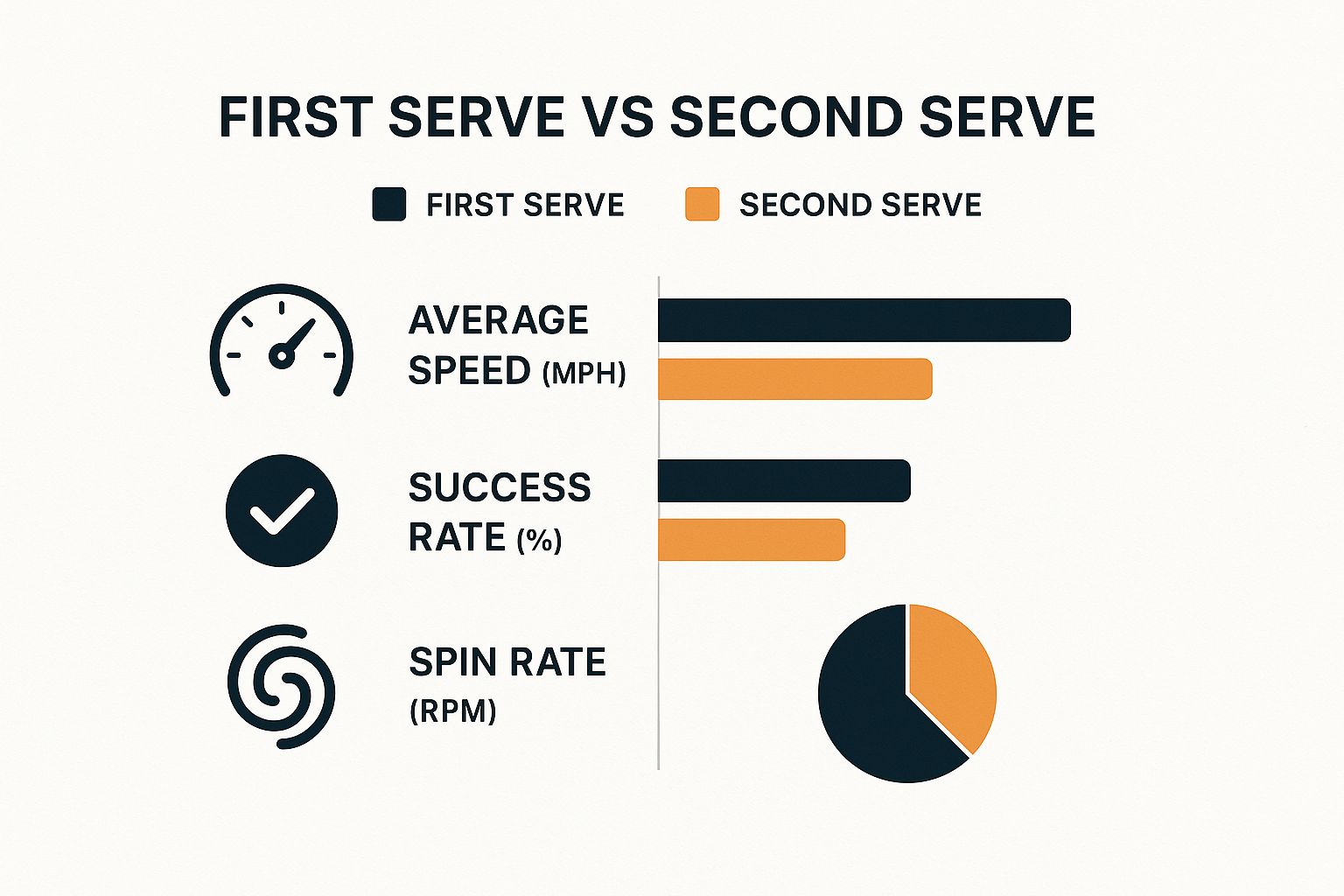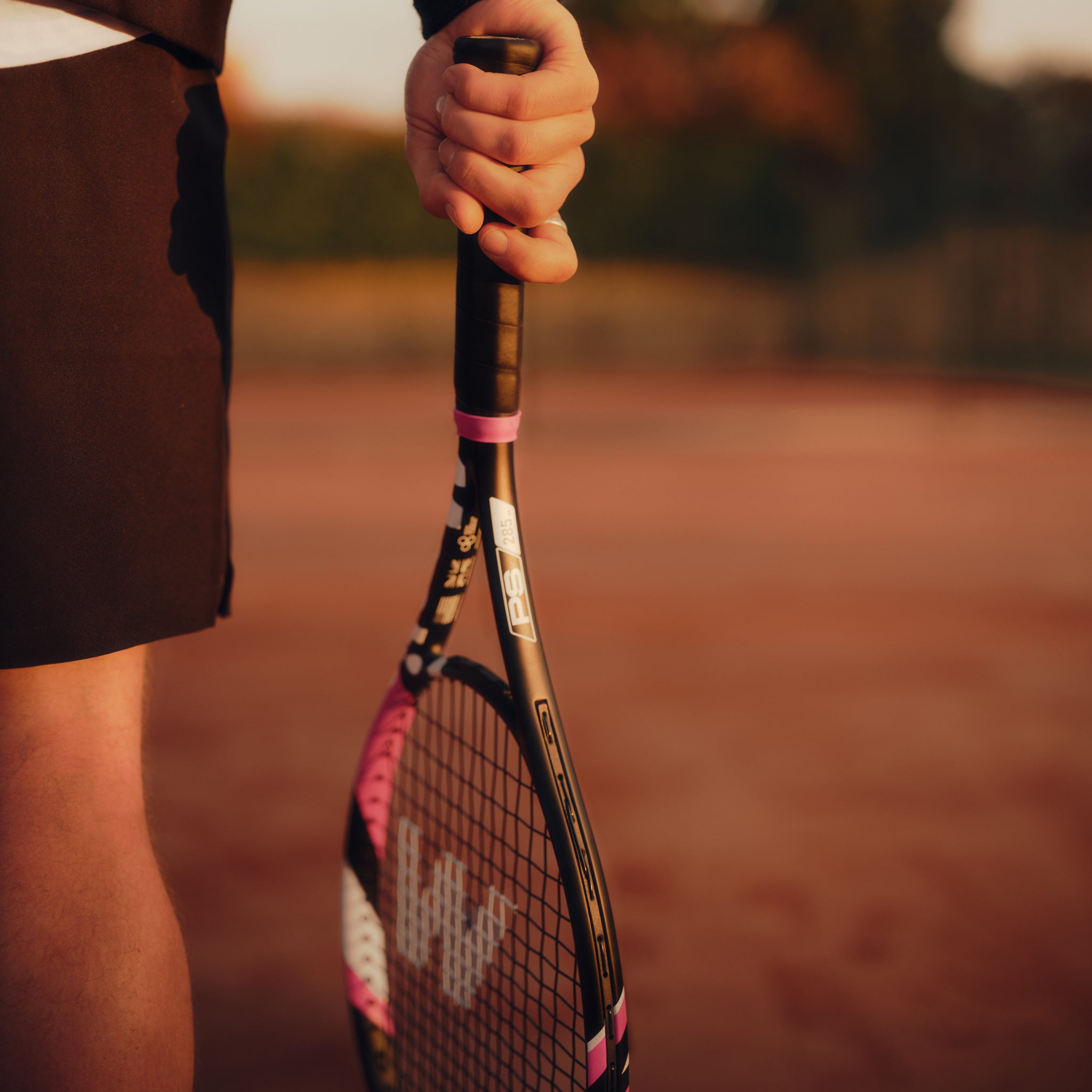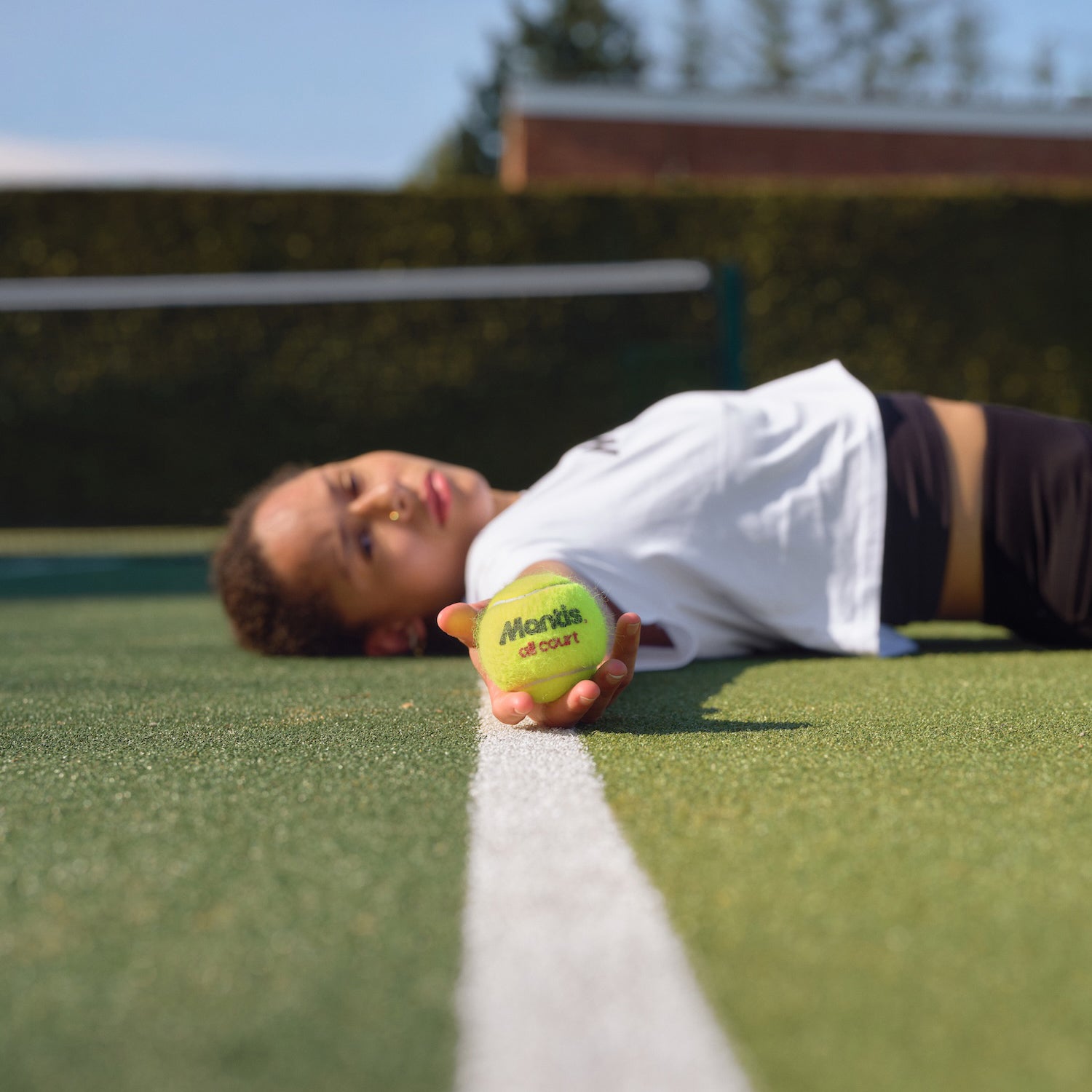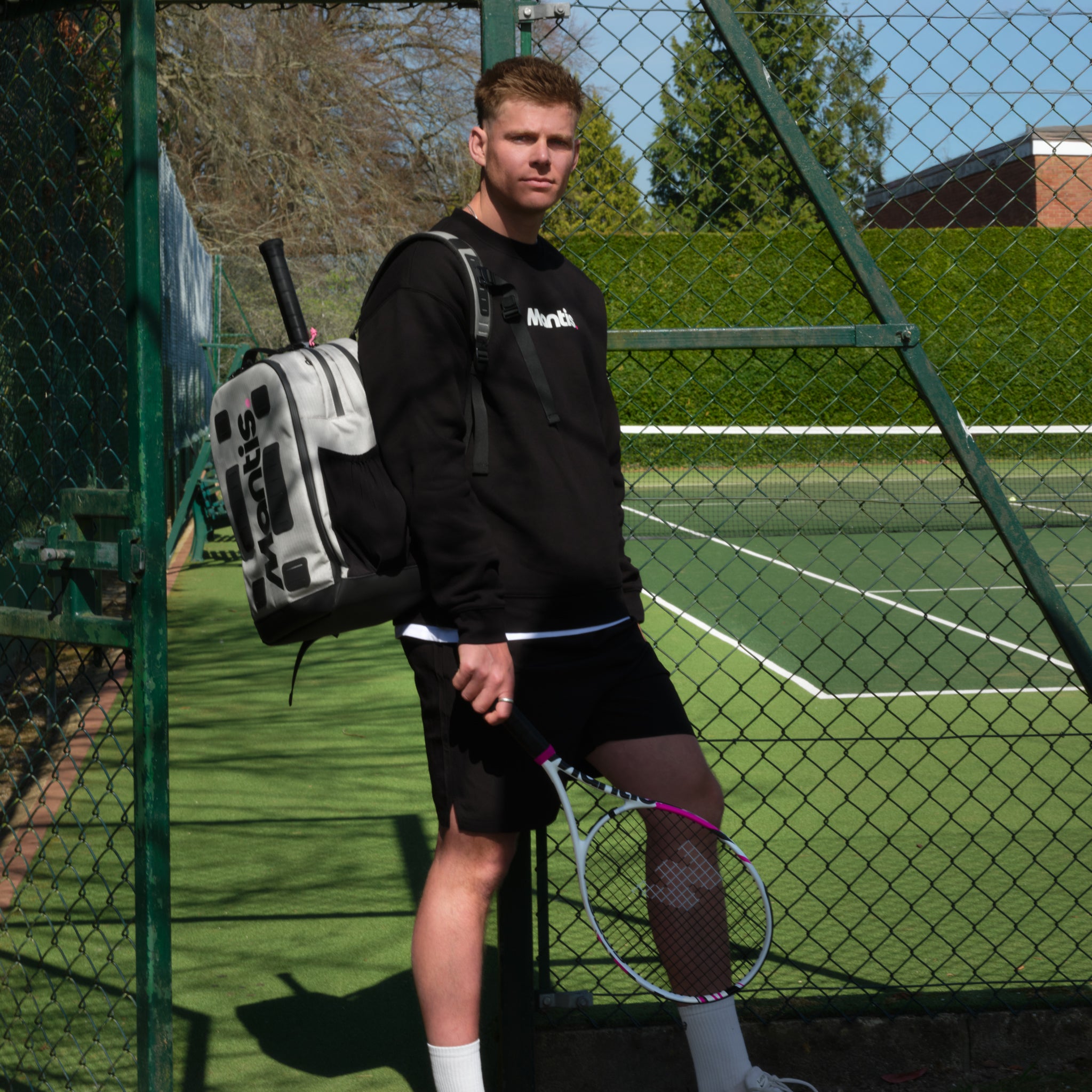
A great tennis serve technique is all about creating a fluid kinetic chain. It’s a sequence that starts from the ground up—with your grip and stance—and flows seamlessly through the ball toss, swing, and follow-through. To build a powerful and consistent serve, you have to get each of these individual pieces right.
Building Your Tennis Serve Technique From The Ground Up
Before you even think about hitting aces, you need to build a solid foundation. The serve is a chain of events, and if that first link is weak, the whole thing will fall apart under pressure. The two most fundamental elements are your grip and your stance. They set the stage for everything that follows.
If your foundation is off, you’re putting a hard ceiling on your potential for power, spin, and placement. I see it all the time with club players: they use a comfortable but flawed forehand or "frying pan" grip. It feels natural at first, but it completely restricts the wrist action needed for natural pronation—which is the real secret to effortless speed.
Why The Continental Grip Is Non-Negotiable
For any serve that's going to be versatile and effective, the Continental grip is the gold standard. There's really no way around it. A good way to think about it is like holding a hammer you’re about to use on a nail. This grip gives you the wrist flexibility to produce slice, kick, and flat serves with only small tweaks to your swing path.
Finding it is straightforward. Hold the racket on its edge and slide your hand down to shake hands with the handle. For a right-handed player, the 'V' shape your thumb and index finger make should sit on the top-left bevel. I know it can feel strange at first, but committing to this grip is probably the single most important change you can make for your serve's long-term health. If you're struggling, check out this guide on how to grip a tennis racket for some extra visual help.
This image really drives home the difference between a typical first and second serve, highlighting that classic trade-off between raw speed and reliable consistency.

As you can see, first serves are all about power. Second serves, on the other hand, lean on much higher spin rates to make sure the ball drops into the box.
Choosing Your Foundational Stance
Once you've got the grip sorted, your stance provides the stable base you'll use to generate power. In modern tennis, you'll see two main stances: the platform and the pinpoint.
A stable, balanced stance isn't just about feeling comfortable; it's about creating a repeatable launch sequence. Inconsistency in your feet almost always leads directly to an inconsistent ball toss and, inevitably, a failed serve.
Each stance has its own biomechanical perks and tends to suit different types of players. Let's break them down.
Here’s a quick look at how the two stances stack up against each other.
Serve Stance Comparison: Platform vs Pinpoint
| Feature | Platform Stance | Pinpoint Stance |
|---|---|---|
| Foot Movement | Feet stay apart, roughly shoulder-width. | Back foot slides up to meet the front foot. |
| Main Advantage | Superior balance and rhythmic consistency. | Generates more momentum for explosive power. |
| Best For | Players who value control and a repeatable motion. | Aggressive players seeking a higher contact point. |
| Commonly Seen With | Pete Sampras, Roger Federer. | Nick Kyrgios, Alexander Zverev. |
There's no single "best" stance—it really comes down to your body, your goals, and what feels right. The platform stance, where your feet stay about shoulder-width apart, gives you incredible balance. It’s a favourite among players who rely on rhythm and control because it makes the motion so easy to replicate.
Then you have the pinpoint stance. Here, you start with your feet apart but bring your back foot up to meet the front one just before you jump. This movement gathers momentum and can help you reach a higher contact point for more power. It's a go-to for more aggressive players.
My advice? Don't just pick one because a pro uses it. Spend some time on the practice court experimenting with both. See which one syncs with your natural rhythm and helps you build that fluid, powerful tennis serve technique you're after.
Choosing a Stance for Tactical Advantage
Where you place your feet before you serve is so much more than a matter of comfort. It's the first strategic decision you make in any point, setting the stage for everything that follows. Forget just picking what feels okay; the right stance should actively support your game plan, whether you're an aggressive serve-and-volley player or a powerhouse from the baseline. A solid tennis serve technique is built on a foundation that is both balanced and tactically smart.
The two main choices, the platform and pinpoint stances, each offer unique biomechanical perks. Your decision should be deliberate, a conscious choice to align your physical base with your intentions on the court.
The Stable and Rhythmic Platform Stance
Think of the platform stance as your anchor. You plant your feet about shoulder-width apart and keep them there throughout the entire motion. This creates a wide, incredibly stable base. Its biggest advantage is consistency, promoting a smooth, repeatable rhythm that's often much easier for players to lock in.
This stance is perfect for players who prioritise control and a fluid, uninterrupted swing. The stability minimises extra body movement, which cuts down on the variables that can throw your ball toss off-kilter. For that reason, many coaches find it helps protect players from excessive lower back and shoulder strain, especially over the course of a long match.
The platform stance is like building a house on a solid concrete foundation. It's stable, reliable, and less prone to shifting under pressure, making it a fantastic choice for developing a consistent service motion.
The Explosive and Dynamic Pinpoint Stance
The pinpoint stance, by contrast, is all about creating momentum. You start with your feet apart, but as you begin your swing, you slide or step your back foot forward to meet your front foot. This gathering motion coils your body up like a spring, ready to unleash.
This technique is designed to propel your body upwards and into the court, helping you make contact with the ball at a higher point. If you're looking to inject some serious power and get a more aggressive angle on your serves, the pinpoint can be a game-changer. It’s a dynamic, athletic move that channels force from the ground right up into the racket.
Of course, all that extra movement demands precise timing. If that foot slide is even slightly off, it can throw your balance and your entire kinetic chain into disarray, making it a much tougher skill to master.
Stance as a Tactical Weapon
Your choice of stance isn't just theoretical; it can give you a measurable edge, especially if you play an aggressive style. For a serve-and-volleyer, every millisecond you save getting to the net is crucial.
Research on expert British players revealed that the foot-back (platform) stance allowed for a quicker transition forward. Players using this stance got to the net in an average of 1.49 seconds, while those using the foot-up (pinpoint) stance took 1.56 seconds. That tiny 70-millisecond difference might not sound like much, but it's enough to get a player about 2.4 metres closer to the net against a fast return—a massive tactical advantage.
Mastering the Ball Toss and Swing Path
If your stance is the foundation, then the ball toss is the architectural blueprint for your entire serve. An inconsistent toss is the root cause of countless serving woes, from frustrating double faults to a complete lack of power.
I can’t overstate this: no single element of the tennis serve technique is more responsible for both brilliant aces and demoralising misses. Getting this right isn’t optional; it’s absolutely essential.
The goal is a smooth, effortless motion that places the ball in the perfect hitting window, time and time again. Forget thinking of it as a "throw." It's more of a gentle "placement." Your tossing arm should stay relatively straight, lifting the ball with your fingertips, not the palm. This simple adjustment minimises unwanted spin and gives you a much more predictable trajectory.
Finding Your Perfect Toss Location
Here's a secret many club players miss: you aren't aiming for one single spot in the sky for every serve. The exact placement of your toss is what dictates the type of serve you can hit. You’ll need to make subtle adjustments to unlock different spins and angles.
- For a Flat Serve: The classic power serve. You'll want to toss the ball slightly out in front of you and into the court, roughly in line with your front shoulder. This position lets you hit up and through the ball to generate maximum pace.
- For a Slice Serve: To get that wicked curve, the toss moves slightly to your right (for a right-hander). This positioning allows you to swing around the outside of the ball, creating the sidespin that pulls it away from your opponent.
- For a Kick Serve: This one feels a bit strange at first. You need to toss the ball slightly behind your head. This forces you to swing up sharply on the ball in a low-to-high arc, which is what generates the heavy topspin that makes the ball "kick" up aggressively after the bounce.
Your ball toss isn't just about height; it's a strategic placement that predetermines the outcome of your serve. A toss that's off by just a few inches can make hitting your intended target nearly impossible. Consistency here breeds confidence on match day.
A great way to build muscle memory is to practise tossing without even hitting the ball. Seriously. Just stand in your service stance, perform your toss, and let the ball land. Is it landing in a consistent spot? For a flat serve, it should land just inside the baseline, near your lead foot.
Creating a Fluid Swing Path
With the toss sorted, let's look at the swing. A very common mistake I see is players thinking of the serve as distinct, jerky stages: toss… pause… swing. This kills momentum. A powerful serve is one continuous, fluid motion.
The "trophy pose," with your racket up and your tossing arm extended, isn't a static position you should hold. It's simply a point you flow through. As the ball reaches its peak, your body should be coiling like a spring—this means a deep knee bend and, most importantly, the racket drop.
Your racket should drop down your back as if you were trying to scratch it between your shoulder blades. This isn't a forced action; it's the natural result of your shoulder rotating and your elbow driving upwards. This drop is what creates the "whip" effect, generating immense racket head speed with what feels like very little effort.
From the bottom of that racket drop, the swing should feel like you're throwing your racket up and out towards the ball. Your body uncoils in a powerful sequence—legs, hips, torso, then arm. The final piece of the puzzle is pronation, where your forearm naturally rotates through contact, adding a final snap of speed.
Don't try to muscle the ball. Trust the kinetic chain you've built.
How to Forge Your Serve into a Weapon
Okay, so you've built a consistent serve. It goes in, points start, and that's great. But now it’s time to move beyond just starting the point and start dictating it. We're talking about turning your serve into a genuine weapon—one that generates intimidating speed and heavy, unpredictable spin.
This isn't about just gritting your teeth and trying to swing harder. The real secret is in the physics of your body. Professional players aren't just stronger; they are masters of the kinetic chain. They use the ground for power, exploding through their legs and torso to create massive racket head speed. It’s all about efficient energy transfer, where tiny tweaks in the sequence can add serious pace.
Unlocking Power with Rotation and Pronation
Forget the idea that a big serve comes from a big arm. Real power starts from the ground up. You push off with your legs, and that energy travels up through your hips and torso. As your body uncoils like a spring, that force is channelled into your shoulder, down your arm, and finally, unleashed through the racket.
The final piece of this puzzle—the one that creates that explosive "pop"—is forearm pronation. Think of it as the snap at the end of a whip. Just before and as you make contact with the ball, your forearm naturally rotates inwards. For a right-hander, it’s the same motion as turning a doorknob anti-clockwise. This single, fluid action is what accelerates the racket head through the ball, giving you that blistering pace on a flat serve or the sharp brushing action needed for spin.
So many club players make the mistake of trying to "muscle" the serve with a stiff, pushing motion. You have to fight that instinct. True speed comes from staying loose and letting that fluid, whip-like acceleration happen, with pronation as the final, explosive link in the chain.
Engineering Your Serve for Different Results
To really control the court, you need more than a one-trick pony. The beauty of a solid, fundamental motion is that you can produce a flat, slice, or kick serve with only small adjustments to your swing path and where you hit the ball. You don't need to completely overhaul your technique for each one.
- The Flat Serve: This is your cannon. For maximum velocity, you want a direct swing path that meets the ball squarely on its back. The key is to think up and through the ball at the absolute peak of your reach.
- The Slice Serve: To get that wicked sidespin, you need to brush the side of the ball. Picture the ball as a clock face. If you're a right-hander, you're trying to swing across it from roughly the 3 o'clock position to the 9 o'clock position. This makes the ball swerve away from a right-handed opponent, pulling them off the court.
- The Kick Serve: This is the most complex shot, but it's a game-changer. Here, you need to brush aggressively up the back of the ball, swinging on a path from about 7 o'clock to 1 o'clock. This imparts heavy topspin, causing the ball to leap high and kick away after the bounce, often jamming your opponent and forcing a weak, defensive return.
Lessons from the Unorthodox
Sometimes, the players who break the mould teach us the most. Take Andy Roddick, whose serve was a familiar weapon on the UK circuit and beyond. His motion featured a famously abbreviated backswing and a high elbow—not exactly textbook. Yet, it allowed him to generate incredible power and spin, leading to a monster 155.0 mph (249.4 km/h) serve.
His success had a real influence on UK coaching, proving that there wasn't just one way to generate power. It showed that unique biomechanics, focusing on explosive rotation from a compact motion, could be just as effective. It's one reason why seeing serves clear 120 mph is far more common in top-level UK tennis today than it was a generation ago.
Mastering these different serves transforms the shot from a simple way to start the rally into a powerful tactical tool. Once you understand the biomechanics behind raw speed and the subtle tweaks needed for spin, you can start winning points from the very first ball.
Adapting Your Serve for the Deuce and Ad Courts
A truly dominant serve isn’t a one-size-fits-all weapon. The best servers are masters of adaptation, making subtle yet crucial adjustments depending on whether they’re standing on the deuce or the ad side of the court. The angles are different, the targets are different, and as it turns out, your body mechanics should be different, too.
Mastering this situational awareness is a huge part of a well-rounded tennis serve technique. It’s the kind of fine-tuning that separates players who just get the ball in from those who use the serve to control the point from the very first shot. You might not even realise you’re doing it, but elite players make these little changes almost unconsciously.
Biomechanical Differences: Deuce vs. Ad
Interestingly, science actually backs up this court-side instinct. Kinematic studies on elite junior players in the UK have shown clear differences in their motions depending on which side they serve from. The research found that when serving from the deuce court, players had a higher upper torso range of motion and bent their front knee more at impact.
This natural biomechanical shift helps improve the ball's lateral impact point, giving you better control without losing much speed.
So, what does this mean for your game? It confirms that the feeling you get—that you need to rotate a bit more on the deuce side—is a natural and effective adjustment. You can lean into this, consciously trying to get more out of your torso rotation to help you nail those tough angles, especially the serve down the 'T'.
Your serving stance and motion should feel slightly different on each side. Don't fight this. Embracing these small adaptations for each side of the court is a sign of a developing, intelligent serve.
Tactical Adjustments for Each Court
With this biomechanical knowledge in our back pocket, we can now make deliberate, tactical changes to our toss and contact point. This is how you start exploiting the unique angles offered by each side of the court.
Here are a couple of specific adjustments you can start practising right away:
- Serving Wide from the Ad Court (for a right-hander): This is the classic slice serve that pulls your opponent way off the court, opening up everything for your next shot. To get it right, you need to adjust your toss slightly further to the left than you would for a flat serve. This position makes it much easier to swing around the outside of the ball (think 9 o’clock to 3 o’clock), creating the sidespin that gives the serve its wicked curve.
- Serving Down the 'T' from the Deuce Court: This is a high-percentage, aggressive serve that can win you a lot of quick points. For this one, your toss should be slightly further out in front and maybe a touch to the right. This setup encourages that extra torso rotation we mentioned earlier and lets you hit through the back of the ball for a powerful, flat delivery straight down the centre line.
By consciously adapting your technique for the deuce and ad courts, you move from just having a single "serve" to possessing a full arsenal of serves. This kind of strategic thinking is what builds a truly formidable tennis serve technique.
Common Tennis Serve Questions Answered
Even when you feel like you've got the basics down, the tennis serve can be a constant source of frustration. It’s such a complex, full-body motion, and the smallest hiccup can lead to some pretty big problems on the court. Let's tackle some of the most frequent questions and sticking points that I see players run into when trying to improve their tennis serve technique.
So many players hit the same plateaus. Maybe it's a wandering ball toss that completely wrecks your rhythm, or maybe it's a second serve that just seems to float over the net, begging to be punished. We're going to break these down with some clear, coach-approved advice you can take straight to the practice court.
Why Does My Ball Toss Go Everywhere?
An inconsistent ball toss is almost always the number one culprit behind a shaky serve. But here’s the thing: the problem usually isn’t your arm, it’s the rest of your body. Any unnecessary movement, like swaying backwards or forwards before you release the ball, is going to send your toss off course.
Here's a simple way to diagnose and fix it. Go out and just practise your toss without even swinging at the ball.
- Get into your normal service stance and just perform your tossing motion.
- Let the ball drop and pay close attention to where it lands.
- For a reliable flat serve, you want it to land consistently just inside the baseline, somewhere near your front foot.
If it’s still wandering after you’ve quieted your body, the issue might be how you're holding the ball. A common mistake is to cradle it in your palm. Instead, try resting it gently on your fingertips. This simple change stops you from "flicking" your wrist on the way up, which puts unwanted spin on the ball and sends it flying unpredictably. It’s all about a straight, clean lift.
A consistent toss is born from a quiet body. Your tossing arm should act like a simple lift, not a throw. By minimising body sway and using your fingertips, you eliminate the key variables that cause inconsistency.
How Can I Add More Kick To My Second Serve?
Let's be honest, a weak second serve is a massive liability. If your second ball lacks any real bite, it's almost certainly because you're hitting it too flat. You're swinging at the ball instead of brushing up on it. A true kick serve needs an aggressive, upward swing path to create that heavy topspin.
The feeling you're chasing is like brushing up the back of the ball from 7 o'clock to 1 o'clock. That's the motion that makes the ball arc high over the net and then jump off the court. Your ball toss is absolutely critical here, too—it needs to be slightly behind your head, which naturally forces this upward swing.
Don't forget your equipment can play a part here as well. A racket with a more open string pattern can help grip the ball for extra spin, and some strings are specifically designed to maximise spin potential. If you're really struggling to generate kick, it might be worth taking a look at your gear. Learning how to choose a tennis racket that supports your second serve ambitions can genuinely make a difference.
A fantastic drill to get the feel for this is to serve from your knees. It sounds strange, but it forces you to use your upper body rotation and that crucial upward swing to get the ball over the net. It's the perfect way to teach your body the correct feeling for generating spin without just muscling it with your arm.
At Mantis, we craft equipment with purpose, for players dedicated to progress. Our rackets, strings, and balls are designed to help you execute your technique flawlessly under pressure. Find gear built for your ambition at https://mantissport.com.








